Sales orders
The Sales order is the master (superior) document in the Sale module. The book of Sales orders keeps under review sales order registration, one sales order corresponds to one commercial case. It is possible to create other inferior documents from a sales order - Invoice out, Order confirmation, Delivery note, Release note or Reserving card. The inferior documents can be browsed on 5th page of the Sales order. So called free documents form the only exception from this rule.

Picture: Opened menu of module Sale / Processing of sales orders - Sales orders
Sales Orders book
In light of the optimal information processing, it is advantageous to interpret one Sales Order as one commercial case that can be closed separately.
If it is a bigger sales order, it is convenient to divide it into individual sub deliveries and combine them by means of Joint Contracts or by means of the Contract Code field in one unit. In this way, it is also possible to join the sales orders from the various books, branches, cost centres etc. into one unit.
A separate sales order without other documents can be used e.g. for a price quotation setting. A sales order does not have to be realised but it can further serve as information for the later marketing evaluation.
The Sales order does not have any impact on the accounting or on the stock records.
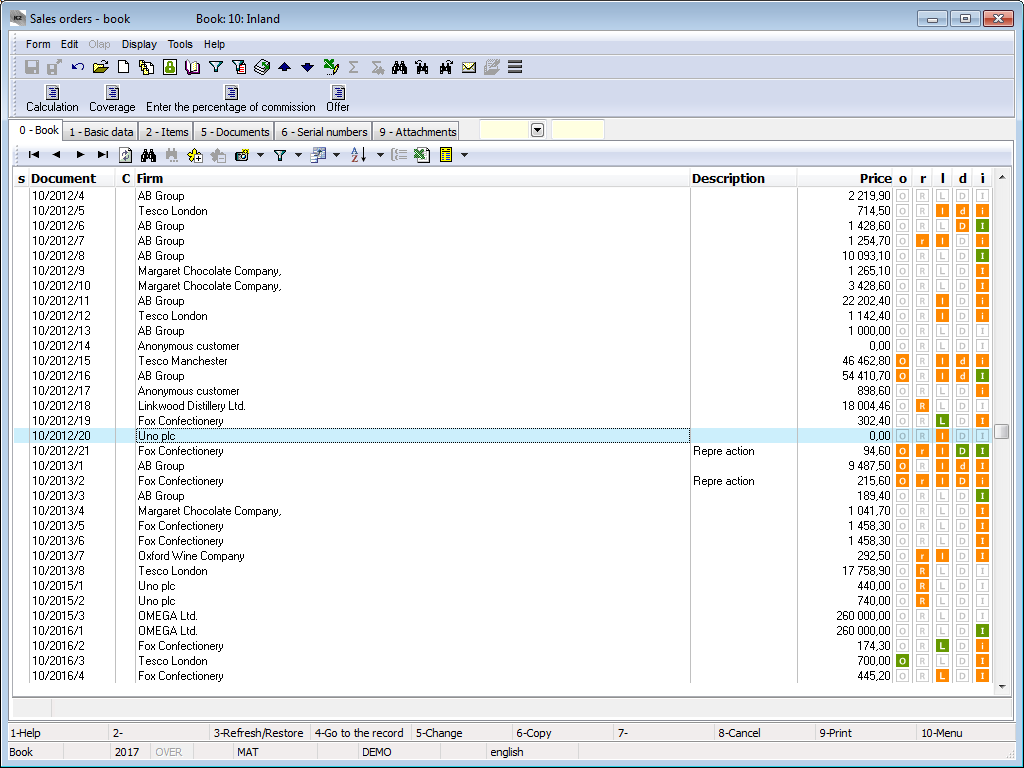
Picture: Sales orders book
Sales order Document
Basic data (1st page)
Basic data, that create a document header, are stated on the 1st page of the Sales Order document. The heading data (first three rows) are also displayed on the other pages of a document.

Picture: Sales Orders - 1st page
Fields Description:
Sales order |
Number and Business year of a sales order. |
Addresses |
This button activates the form for entering the addressee. The form can be also activated by pressing Ctrl+F4 keys. For further information see the Addressee chapter. |
Status |
Field for selection from a code list. This field enables to filter documents according to the selected status by a user. |
Customer |
Basic data about a customer – abbreviation, name, country, city, price group. A structure of these information is set in the Client parameters. |
Prices |
Data about prices – the gross, the net, VAT and the currency code items. |
Currency |
The option is automatically checked according to the entered currency on a document. |
VAT documents |
The option indicates that the Order is issued with VAT. |
It is possible to assign random types and kinds of the notes to the Sales orders, eventually it is possible to use the Heading text or the Footer text. Further description of work with the notes is stated in the Basic Code Lists and Supporting Modules K2 – Notes chapter. The Internal text tab serves for entering a text of any length to a sales order. If a text is entered, the "*" sign will be displayed on the tab. Customer´s internal text tab serves to display customer´s internal text only. The Tasks and Activities tabs are also available. The work with tabs is described in the Tasks - document's tab and Activities - document's tab chapters.
Payment conditions can be displayed on the Payment conditions tab, they can be edited by using the button of the same name.
Basic data of the header are divided into two tabs.
The Data tab contains basic information of the document header.

Picture: Data - Sales orders (1st page)
Fields Description:
Cost centre |
The cost centre which issues a sales order. |
Contract code |
Contract code. |
Device |
Reference to the Device book. It is copied from the Sales Order to the inferior documents. |
Code 1, Code 2, Officer |
The fields enable the user identification, eventually a link to the Officers book. For further description see the Basic Code lists - Code 1, Code 2, Officer chapter. |
Cust. order No. |
Field for entering the customer order number, on the basis of which the sales order has been issued. |
Form of Order |
In which way the customer ordered the article. |
Payment method |
The method of payment for the withdrawn articles - in cash, by bank transfer, cash on delivery etc. It is a user´s code list. On the 1st page of a record, it is possible to determine by set the Cash on delivery selection, that the payment method is "cash on delivery". This flag is used to determine the Cash on delivery in the Consignments module. Note: The Payment Method can influence the rounding of Invoice. For further description see the Rounding Inland Invoices Depending on Payment Method methodology. |
Shipping method |
Shipping method of the articles. |
Method of transport |
Method of transport of the articles. |
Contact person |
A person who has done a deal on the part of the customer. The reference to the Contact Persons book. |
Contact information |
The field can be empty or a random own text can be written in it. |
Exchange Rate |
Currency in which the Sales Order is issued. An exchange rate for a recalculation between a basic currency and a currency of the Sales Order is also displayed in this field. |
Exchange List |
This button opens the Exchange list where you can select from the defined exchange rates. The Exchange rates are defined in the Currency code list. |
Rate by date |
This button inserts the exch. rate, valid on the date of issue of a sales order, from the exchange list. It can be activated only in the Change mode. |
Type |
Type of tax. It is filled into a document from the Suppl./Cust. card (if it is entered here) or from the Book of sales. |
Matching symbol |
Data about a matching symbol. That is further used in the accounting. |
Reference Number |
The reference number of a sales order. It can be automatically created according to the settings in the Books of sale. |
Price Group |
Price group for a sales order. This price group is automatically entered according to a price group stated on the Suppl./Cust. card and further it is copied to the items of a sales order. |
Plan type |
Selection from the Plan Type code list which serves for distinguish of the planning and actual documents. Plan type, which is defined in the Plan type field on the 1st page of the Books of purchase/sale book, is added to the new documents by default (see the Basic Code Lists and Supporting Modules K2 – Plan type). |
Comp. Reg. No. |
Comp. Reg. No. of a customer. If it is not entered, a Comp. Reg. No. from the Customer card is applicable. |
VAT Reg. No. |
VAT Reg.No. of a customer. If it is not entered, a VAT Reg. No. from the Customer card is applicable. |
Tax No. |
Tax No. of a customer. If it is not entered, a Tax No. from the Customer card is applicable. |
Date of Issue |
The date of issue of a sales order. |
Delivery date |
The date to that the articles should be delivered. When inserting a sales item, the date from this field is copied into the Des. dely field on the Sales item form. |
Delivery time |
The Delivery Time in which the articles should be delivered. |
Description |
It is possible to inscribe a description directly or select a text from the code list to distinguish the individual sales orders in the book. |
Issued by |
The name of an employee who has issued a Sales order. |
Changed by |
The date and name of the employee who has made the last change of the Sales Order. |
Payment Conditions |
This button serves to set the payment conditions for the given Sales order. Detailed description is stated in the Purchase and Sale Shared Elements - Payment Conditions chapter. |
There is a table of a price recapitulation in the Tax summary tab.
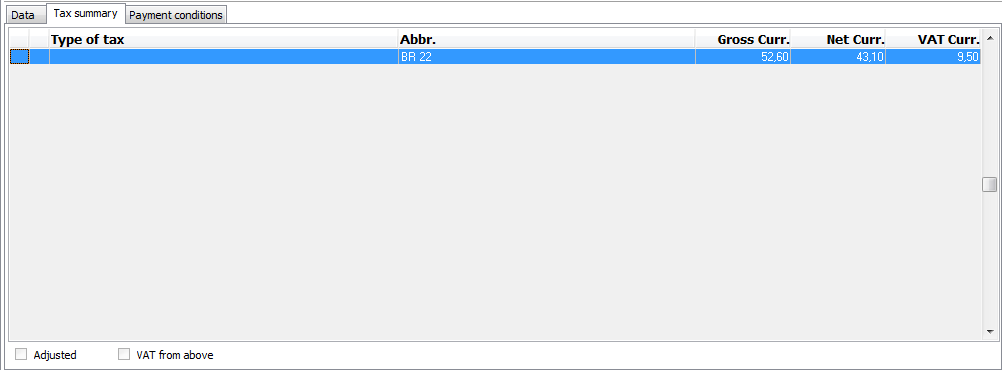
Picture: Tax summary - Sales order (1st page)
Items (2nd Page)
The items, that are the subject of sale, are inserted on the 2nd page of a Sales Order. New item can be inserted in Change mode or in a New record by Ins key, after its pressing the Sale Item form will be displayed. The same form will be displayed, if you indicate the selected item by a light indicator on a sales order and then press Enter key.

Picture: Sales Orders - 2nd page
Data about a planned and actual profit and margin of a document may be displayed in the header of a document. See the further description in the Profit, Margin and Stock Price chapter.
In Change mode, one can use the buttons ![]() ,
, ![]() and
and ![]() to indicate the records. These buttons are described in the Indicate Records chapter.
to indicate the records. These buttons are described in the Indicate Records chapter.
Values in the documents items including discount, can be adjusted in bulk by means of Change items in bulk button in Change mode. For further description of this function see the Change Items in Bulk and Purchase and Sale Items chapters.
The Item routing button serves to display a Routing Variant of an indicated product or a semi-finished product item.
There are the buttons and fields, which are related to the advances received, in the lower part of the 2nd page of a sales order. The amounts are stated in a currency of a sales order.
Selected fields' description:
New advance to sales order |
The button for creating a new Advance Received with the pre-filled data from a Sales Order. |
New advance to sales order in % |
The button for creating a new Advance Received with the pre-filled data from a Sales Order. Enter an amount of the Advance in %. |
Advances to sales order |
The button to display the Advances to a Sales Order. |
Advances to customer |
The button to display the Advances to a Customer. |
Deducted from adv. to sales order |
Amount of the Advances to a Sales Order which has been already deducted on an Invoice. |
Deducted from adv. to customer |
Amount of the Advances to a Customer that has been already deducted on an Invoice. |
Remains to deduct from adv. to sales order |
Amount of the paid Advances to a Sales Order that has not been deducted on an Invoice yet. |
Remains to deduct from adv. to customer |
Amount of the paid Advances to a Customer which has not been deducted on an Invoice yet. |
Further description of issuing an advance received is stated in the Process during the receiving an advance from a customer chapter.
There are the bitmaps, that inform about the existence of Advances, in the heading of the Sale order on the 1st and 2nd page:
 informs the user about the existence of a paid non-deducted Advance to a Sales Order,
informs the user about the existence of a paid non-deducted Advance to a Sales Order, informs the user about the existence of an unpaid Advance to a Sales Order.
informs the user about the existence of an unpaid Advance to a Sales Order.
Note: If a selected item is indicated by the light indicator and you press the Ctrl+F8 keys, a form for the creation of a new Service Sheet will be displayed. It is necessary to set the Complaint/Service module for this functionality.
Documents (5th Page)
There is an overview of all documents that are linked to a Contract, on the 5th page of the sales order. Switching among the particular documents can be executed by the simultaneous pressing Ctrl key and a beginning letter of the document. The selected document can be also displayed by Ctrl+Enter key combination.
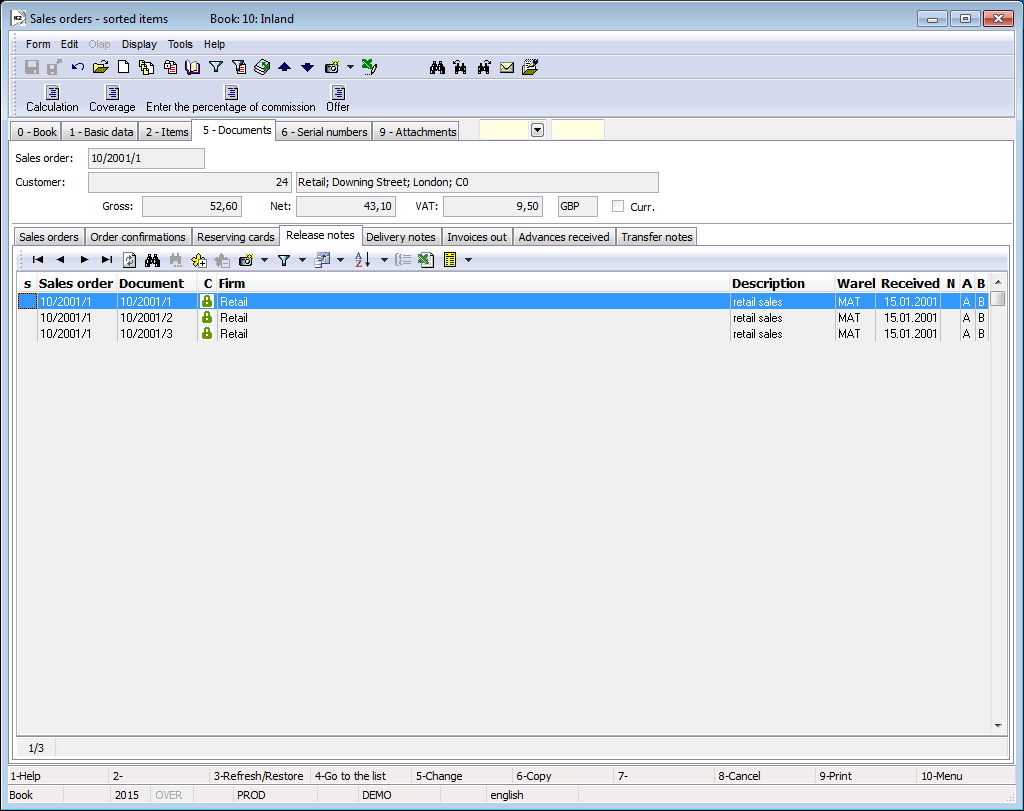
Picture: Sales Orders - 5th page with the open Release Notes tab
Ext. documents (9th Page)
On the 9th page of a sales order you can insert the documents and assign the links to the document as in the other documents of IS K2. Further description of work with this page is stated in the chapter Basic Code Lists and Supporting Modules K2 – 9thPage.
Functions of Sales Orders Module Menu
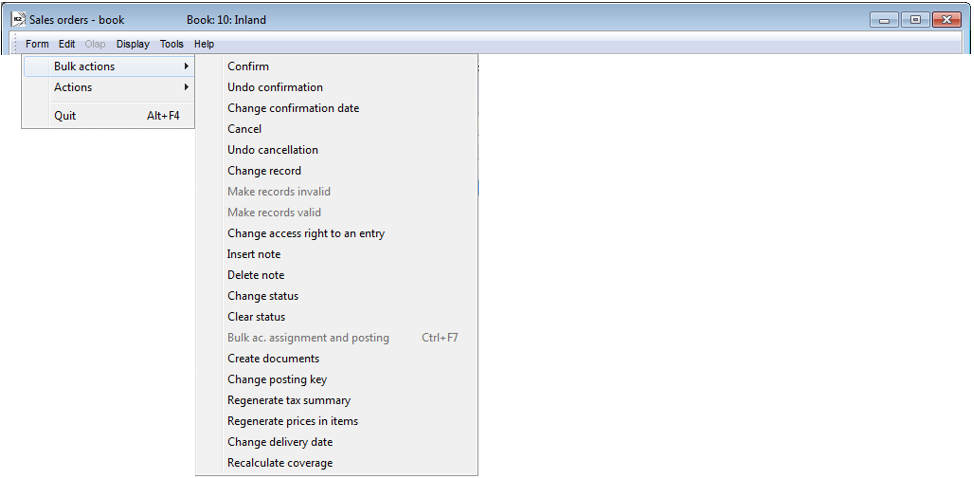
Picture: Functions of Sales Orders Module Menu
Form – Bulk Actions:
Change Status |
It enables to change the Status field in bulk for the selected records. |
Change delivery date |
On the unconfirmed Sales orders, this function enables to edit:
VAT and Gross amounts are recalculated after the change of VAT rate. If there is an unconfirmed inferior document on a sales order item, the amounts on an inferior document will be also changed. |
Recalculate coverage |
It performs the evaluation of a status of a coverage of items of all documents, which create a requirement of production or sale (items of the unconfirmed documents with the reservation flag). The list of the recalculated articles is given by cards, which are currently in the filter on Sales orders. Status of a coverage of a whole document, in job cards also a status of coverage of individual operations, are also calculated on the basis of a status of a coverage of individual items. The evaluation of each item is executed on the requirement date. On the displayed form, it is necessary to set on what conditions a recalculation should be executed. This setting influences a loading coverage data and thereby an evaluation of coverage of the items. Setting of fields in the form is remembered.
The function is also available as a Shortcut, which may be placed to the desktop of a program or to the Task Scheduler as the automatically running action. In this case, coverage of all article cards is evaluated. It is distinguish between a total coverage and a coverage by stock for a coverage of items / documents. While at Total coverage all future movements are evaluated (it is evaluated according to the state, which is available in the Coverage of demanded article function), at Coverage by stock it is evaluated, whether the item can be covered by existing inventory in stock. Coverage of items - total (BFCovered)
Coverage of items - by stock (BFCoveredS)
Coverage of a sales order
|

Picture: The Recalculate coverage form
Form – Actions – Documents:
Job cards |
Searching a job card of a product. |
Actions:
Calculation of a stock price of a product |
It offers the update of Article stock price. |
Functions over Sales orders
Ctrl+F8 |
It displays the Gantt production status - a chart displaying a status of production fulfilment. From the page 0: it loads all sales order items. From the page 2 in the Browse mode: it loads the currently marked item or the items indicated by asterisks. The detailed description of a chart is stated in the Production status Gantt chapter. |
Ctrl+Shift+F6 |
For the currently marked item, it opens a form of Wizard of the stock record and enables manually adding the selected combination (contract code + batch + location) into the document item directly from the rows of documents items. (2nd page, in Change mode). |
Ctrl+Shift+F8 |
A new Service sheet will be created for the currently marked item (the 2nd page in the Browse mode). It can be run from the all sale documents. |
Cancel Sales orders (F8)
If the invoice has been already saved (the number has been assigned to it), it cannot be deleted by any way. It is possible to cancel it by pressing F8 key only if it is not confirmed. The cancelled invoice remains in the database with the undisturbed content, it has only a flag of the cancellation. Therefore, it is always possible to find out what was its content. It is not possible to change the cancelled invoice any more as when confirmation.
If a sales order contains some confirmed inferior documents, then it cannot be cancelled. If a sales order contains some unconfirmed inferior documents, then a program will ask, whether the inferior documents should be cancelled too. If the user has the right, then all documents will be cancelled at the same time.
Reports - Sales orders
Sales order
Process No.: ZAK014 |
Report ID: SZAK002 |
File: ZAK_DOK01.AM |
Report description: Sales order of a customer. |
||
Address in the tree: [Sale/Processing of sales orders] [Sales orders] [Sale/Processing of sales orders] [Sales orders] [Print reports - Lists] |
||
Report parameters:
Assignement - No Yes - the posting of documents is displayed (data from the 3rd page of the document). |
BarCode - No Yes - bar code is displayed. |
Batch - No Yes - batches for an item are displayed. |
BatchAttr - 0 0 - Nothing is displayed; 1 - batch parameters are displayed; 2 - required batch parameters are displayed. |
BusinessRegister - Yes Information about the Business register from the Configure own companies are displayed. No - it is not displayed. |
CataloguePrice - Yes Yes - it displays the catalogue prices for the items. |
CodeOfCurrency - No Yes - a code of currency is displayed (e.g. USD). No - a sign of currency is displayed (e.g. $). |
CombineOrigItem - Yes Yes - it combines items with the same "OrigItemF" (if there is no difference in a price and in some other attributes).. |
Contacts - 1;Addr;TaxNum;Tel1;Fax1;Email1;WWW Parameter has a total of 10 positions, the first three are firmly set: 1. position: a user, whose contacts from the user´s card (telephone, mobile, fax, email) are printed. Options: 0 - no user´s contacts, 1 - the user who has issued the document, 2 - the currently logged-in user - who prints a document. 2. position: "Addr" - if it is entered, an address of the firm is displayed. 3. position: "TaxNum" - if it is entered, the ID-No. and VAT Reg.No. are displayed. 4. - 10. position: listed types of electronic addresses of the own company (ie. there may be up to 7 types). Example: (Contacts - 1;Addr;;TEL1;FAX1;WWW1): The address of a firm is displayed, under it the contacts from a card of the user, who has issued the document, (Tax No. are omitted by empty string on the 3rd position) electronic addresses with the types Tel1, Fax1, WWW1 follow. Note: If some of the data are suppressed, no free place will remain. The default order in a report is always: address, Tax No., user's contacts, the entered electronic addresses of the own company. |
DefaultExport - No This parameter is described with the other export parameters in the Report parameters for a bulk sending by email chapter. |
Description - No Yes - it displays information from the Description field from the 1st page of the document. |
DescriptionFromItem - No Yes - a supplement, that is entered into the Description field on an item of a document, is displayed. |
Discount - Yes Yes - a discount entered in an item is displayed. |
DraftLabel - Yes Yes - a "DRAFT" text is displayed at the background of the report, if a document is unconfirmed. No - a "DRAFT" is not displayed. |
Export_... - various parameters The export parameters, that are collectively described for all documents in the Report parameters for a bulk sending by email chapter, are a part of the report too. |
Interactive - No No - an input form for entering parameters values is displayed. |
JCKindItem - A list of the kinds that are printed in a tree of the Job Cards (it is necessary to separate more kinds by a semicolon). |
JCTreeLevel - 1 0 - all levels of Job Cards are displayed at the items; 1 - without the Job Cards 2,3,4... - number of levels. |
KeepEnvelopeFormat - No No - a blank space under a place for envelope window is hidden. Effect of a save space is multiplied if the "BarCode" parameter is set on "No". It has meaning, if the user does not use the window envelopes, he does not want to fold the printed document to an envelope according to the cam line guide of a document. Yes - a place is not hidden - the line between items and the address part will always be in one third of a page. |
LangAccordtoParams - No If the report should be printed in a language, that is set in the "Field language" and "Report language" parameters, then you must set a value of the parameter on "Yes". |
LeftEnvelopeWindow - No Yes - address of a customer is printed in the right side (determined for sending documents by mail in abroad where a window for an envelope is in the left side); No - address of a customer is on the left side. |
LeftShift - 5 By how many mm the edge of the report will be moved to the left (it serves for setting a print on a printer). |
LogoPictureFooter - 0 Parameter adjusts the footer logo display. If the parameter is empty, a logo according to the setting of the Footer picture parameter in the Administration - setting of own companies function will be displayed. 0 - nothing is displayed, but a place keeps free (for a headed paper), 1 - neither any picture nor free space. Name of a file with png suffix - specific picture in the Pictures directory of the given firm. |
LogoPictureHeader - Parameter adjusts the header logo display. If the parameter is empty, a logo according to the setting of the Header picture parameter in the Administration - setting of own companies function will be displayed. 0 - nothing is displayed, but a place keeps free (for a headed paper), 1 - neither any picture nor free space. Name of a file with png suffix - specific picture in the Pictures directory of the given firm. |
NumberOfItem - 1 0 - no number is displayed, 1 - number of a sales order item is displayed; 2 - order number is displayed. Always in "#001" format. |
OneLineItem - No Yes - document item is always displayed in 1 line. |
SerialNumber - No Yes - it displays the serial numbers on the items. |
Sign - @Vyst;;; Parameter has 5 positions: 1. position determines a person whose signature should be displayed. It may be a picture called according to the Logname of a user, who has issued the document (@Vyst) or who prints the document - so according to the current login (@akt), or the current Logname. Picture has to always be in Logname.png format and it has to be located in Pictures directory. 2. position: picture height. 3. position: distance from the left edge. 4. position: distance of a picture from the upper edge of the given section. 5. position: picture width. Example: (Sign - @vyst;27;47;0;83) It prints a signature of a user who has issued the document, 27 points high, 47 points indented from the left margin, at the upper margin. A picture is 83 points wide. |
SortBy - The field is filled with the value of the field from the sales items (e.g. C_Zbo;Zkr or CF_CeJePlM). Items on a document will be sorted according to the parameter value. Parameter is empty by default. If the value of this parameter is entered, then the items will not be combined, even if the CombineOrigItem parameter is set on Yes. |
StateOfOrigin - No Yes - a code of tariff and a state of origin are displayed at the items. If it is filled on a batch, information from a batch are displayed; otherwise the data from the Article card are displayed. |
SupplFromArticles - 0 - Nothing is displayed, Empty value - Business text from the Article card is displayed, otherwise the entered type of a supplement from the Articles card (e.g. supplement of the DB type) is displayed. |
SupplFromCustomer - DZ 0 - Nothing is displayed, Empty value - Business text from the Customer card is displayed, otherwise the entered type of a supplement from the Customer card (e.g. supplement of the DZ type) is displayed. |
SupplFromItem - TX A type of a supplement entered on an item of a document is displayed. |
SupplFromMandant - TEXT The TEXT value displays an information from the General information field from the own company. Otherwise the entered type of a supplement from the Client parameters is displayed. |
TaxRecapitulation - Yes Yes - tax recapitulation is displayed. |
Title - The entered value of the parameter is displayed as a title of the report. If the parameter is empty, an original name of the document is printed. |
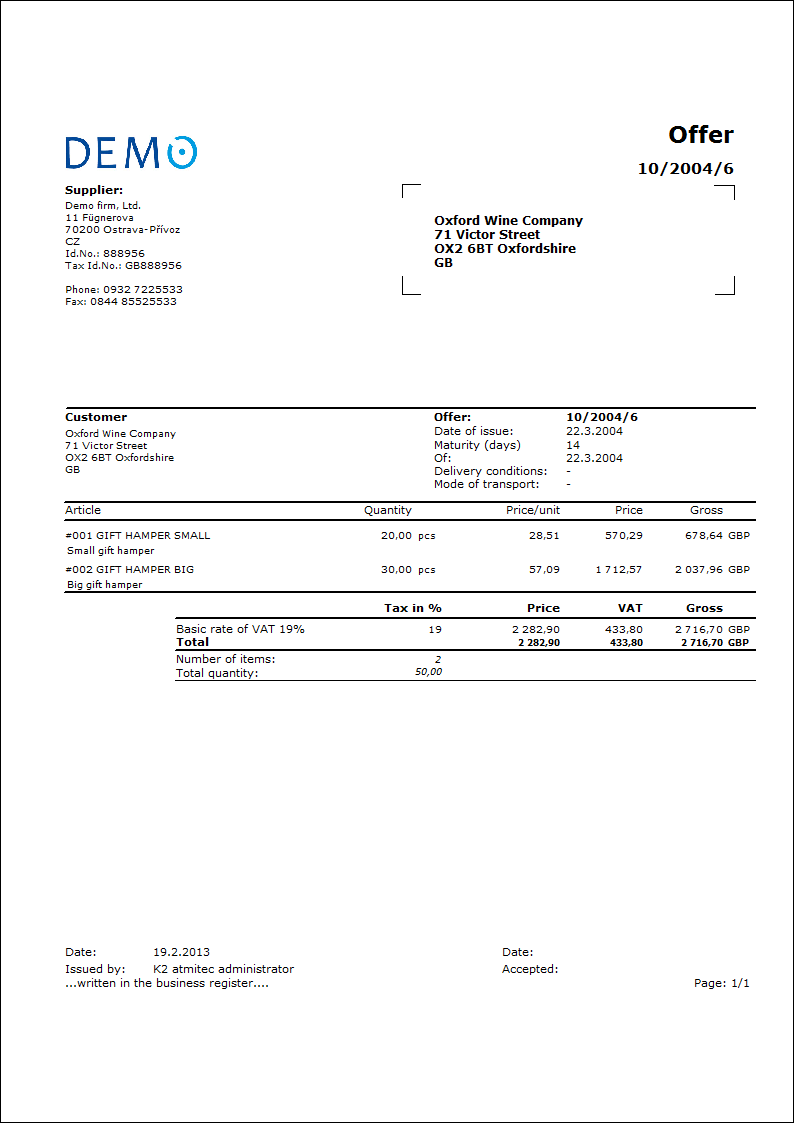
Statement of sales orders
Process No.: ZAK014 |
Report ID: SZAK005 |
File: ZAK_VYP01.AM |
Report description: Statement of sales orders |
||
Address in the tree: [Sale/Processing of sales orders] [Sales orders] [Print reports - Lists] |
||
Report parameters:
SupressSum - No Yes - total for items will be hidden. |
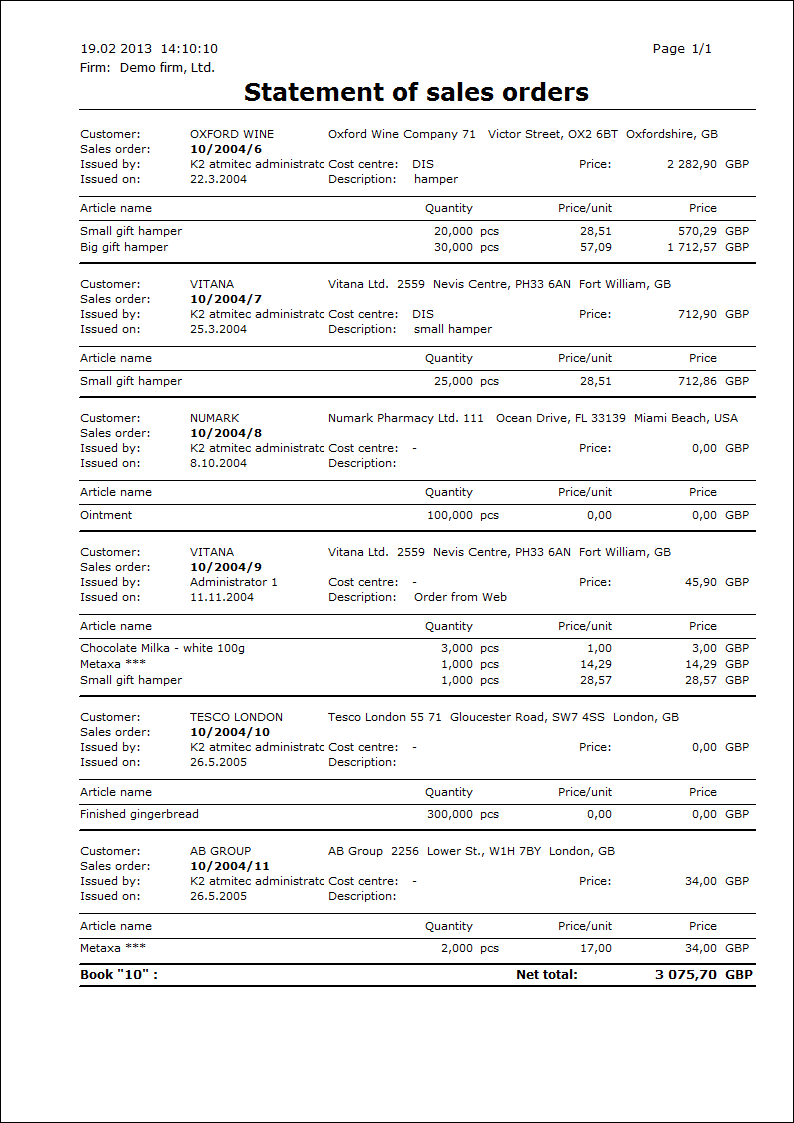
List of sales orders
Process No.: ZAK014 |
Report ID: SZAK003 |
File: ZAK_SEZ01.AM |
Report description: List of sales orders. |
||
Address in the tree: [Sale/Processing of sales orders] [Sales orders] [Print reports - Lists] |
||
Report parameters:
ShowDocDescription - No Yes - description of document will be displayed. |
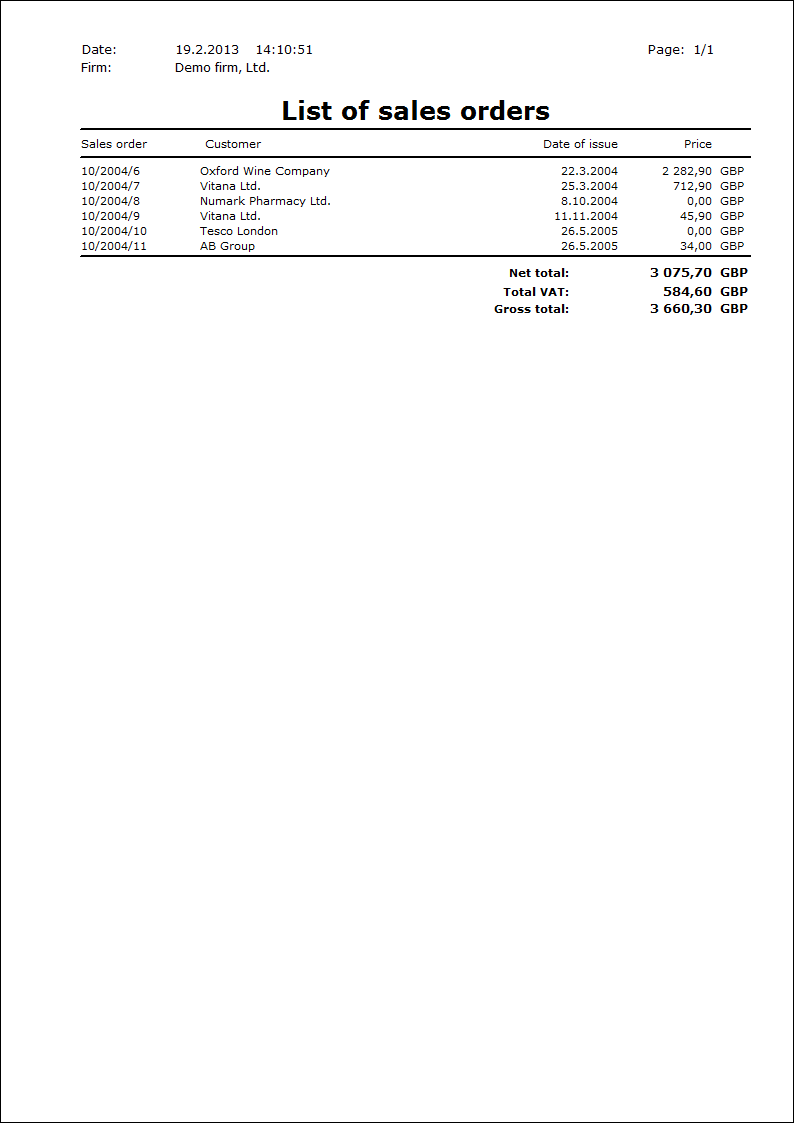
 : an item will be completely missed on the requirement date.
: an item will be completely missed on the requirement date.